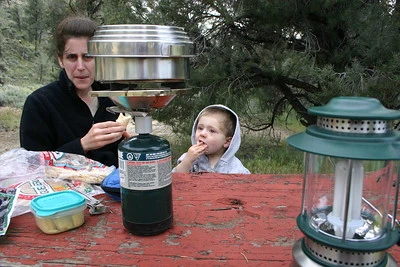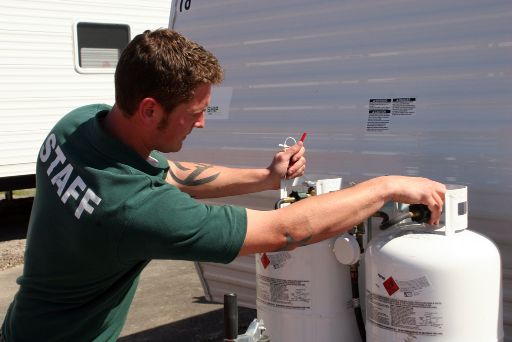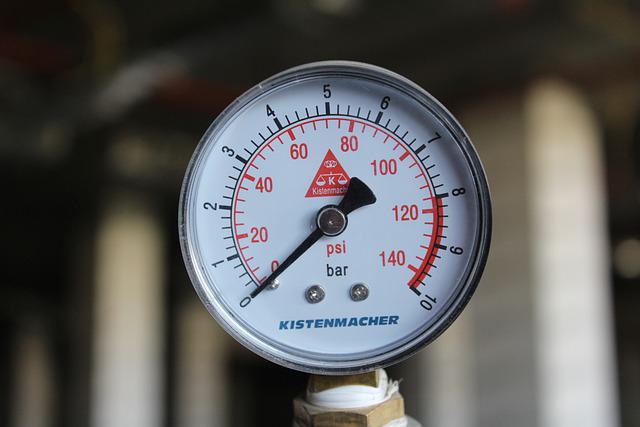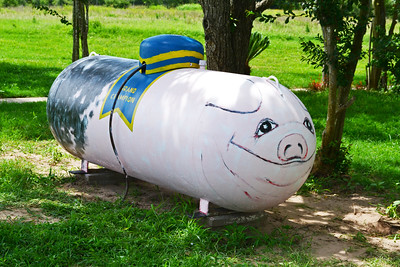
You know how it goes if you’re an experienced camper: every trip comes with its own unique set of questions, calculations, and plans.
One question that pops up more often than not is “How Much Propane do you Need While Camping??” If that’s a puzzle you’re trying to solve, you’re in the right place!
This thorough guide is set to answer that question and more. We’re about to explore the ins and outs of usage for this outdoor activity, factors that influence how much you need, and some clever tips to manage and save your propane effectively.
Whether you’re a newbie preparing for your first outdoor escapade, or a seasoned nature lover looking to refine your gear and planning, grasping your needs can transform your adventures for the better.
So, are you ready to dive in? Let’s get started.
How to Calculate Propane Usage
Knowing how much propane you’ll need for your trip can make all the difference in having an enjoyable, hassle-free outdoor adventure. To estimate your needs, you can follow some simple steps:
A. Basic Formula for Estimating Usage:
Typically, a standard cylinder holds about 4.7 pounds of propane and can deliver approximately 22,000 BTUs per pound. That means a full cylinder provides around 103,400 BTUs. If you know the BTU rating of your gear, you can calculate how many hours a cylinder will last by dividing the total BTUs in the cylinder by the BTU consumption of the appliance per hour.
B. Detailed Step-by-Step Guide to Calculate Usage:
- Step 1: Check the BTU rating of your gear. You can usually find this information in the product manual or on the manufacturer’s website.
- Step 2: Determine how many hours you plan to use each piece of equipment each day. Multiply the BTU rating by the number of hours to get the total BTUs consumed per day.
- Step 3: Repeat step 2 for each device you’re taking camping.
- Step 4: Add up the total BTUs for all equipment to find your total daily BTU usage.
- Step 5: Divide the total BTUs in a cylinder (103,400 BTUs for a standard cylinder) by your total daily BTU usage. This will give you the number of days a single cylinder will last.
C. Examples of Calculation for Different Scenarios:
Example 1: You’re going out for two days, and you’ll use a stove rated at 10,000 BTUs per hour for two hours each day. The stove would consume 40,000 BTUs over the two days, so a standard cylinder would be more than sufficient.
Example 2: You’re going out for five days, and you’re using a stove (10,000 BTUs per hour for two hours daily) and a heater (5,000 BTUs per hour for four hours nightly). The total BTUs consumed over the five days would be 200,000 BTUs, meaning you’d need approximately two standard cylinders.
Remember that these calculations are estimates and actual usage may vary based on factors like equipment efficiency and weather conditions. It’s always a good idea to bring a bit more propane than you think you’ll need, just to be on the safe side.
Factors Influencing the Amount of Propane Needed for Camping
When heading out for a trip, one key question on most campers’ minds is how much propane they need to carry. It’s essential to carry an adequate supply of gas for your needs, as running out midway through your trip can disrupt your plans and make your outdoor experience less enjoyable. However, estimating the amount of propane you need can be tricky because it depends on several factors. Let’s take a closer look at these variables:
A. Duration of the Trip:
Just think about it – the longer you’re out in the wild, the more gas you’re going to burn through. It’s simple logic: more days equals more meals to cook and nights to heat up.
B. Types and Number of Devices Used:
The specific appliances and devices you plan to use can greatly impact the amount of propane you’ll need. For example, if you’re using a stove, heater, and lantern, your consumption will be higher than if you were only using a stove.
C. Frequency and Duration of Appliance Usage:
It also comes down to how you use your appliances. If you’re the type who likes hot meals throughout the day and prefer to keep warm with the heater running all night, you’ll understandably use up more gas.
D. Size and Efficiency of Equipment:
Here’s another thing – the size and efficiency of your gear matter. You’re going to need more propane if you have larger, less efficient devices. On the flip side, smaller and more efficient gear can help you save on propane.
E. Weather Conditions and Altitude:
Cold weather conditions can increase your need for heating, thereby increasing your consumption. Additionally, high altitude can affect the performance of devices, possibly causing them to use more propane.
F. Personal Cooking and Heating Preferences:
Lastly, your personal preferences play a crucial role in determining your needs. If you prefer hot meals at every mealtime or like to stay warm by keeping the heater on, you’ll need more propane.
To ensure you have an adequate supply for your trip, it’s vital to consider all these factors. This can help you avoid running out of propane when you need it most, ensuring a smooth and enjoyable experience.
Why You Need a 5 lb Propane Tank for Camping
If you’ve been wondering about the best tank to bring along on your trip, I’ve got you covered. I’m here to tell you why a 5 lb tank might just be your new best friend on your outdoor adventures.
- Travel-friendly: First off, let’s talk about how easy it is to carry around a 5 lb tank. Its smaller size and light weight make it a breeze to handle, especially when you’re juggling all your other gear.
- Perfect for Short Trips: Planning a weekend getaway? A 5 lb tank could be just what you need. Holding around 1.2 gallons of propane, this little tank can power through several meals, depending on your usage, of course.
- Safe and Easy to Stow Away: One of the great things about a 5 lb tank is its compact size which makes it simpler and safer to store. It snugly fits in your vehicle without hogging too much space and can be stashed away safely at your campsite.
- Easy on the Pocket: If you’re a casual enthusiast, spending big bucks on a larger tank might not make sense. A 5 lb tank is generally more affordable and can adequately cater to your needs. And don’t forget, propane doesn’t spoil, so you can always use any leftover propane on your next adventure.
- Reusable: Just like its bigger siblings, a 5 lb tank can be refilled, making it an economical and environmentally friendly choice. But remember, if your tank is over 12 years old, you might need to get it requalified before refilling it.
One-Time Use Versus Refillable Propane Tanks
Propane is an essential part of many trips, used for everything from cooking to providing heat. When deciding between one-time use and refillable tanks, several factors come into play. Let’s dive into the differences and benefits of each to help you make the best choice for your needs:
One-Time Use Tanks:
- Convenience: One of the main benefits of one-time use tanks is their convenience. They are easy to use, portable, and readily available at many outdoor, grocery, and convenience stores.
- Easy Disposal: Once a one-time use tank is empty, you can dispose of it, eliminating the need to carry around an empty tank. However, make sure to follow local regulations for safe disposal.
- Ideal for Occasional Users: If you’re an infrequent camper or only use propane sparingly, one-time use tanks may be the most cost-effective choice.
Refillable Propane Tanks:
- Cost-Effective in the Long Run: While the upfront cost of a refillable tank is higher than a one-time use tank, it can save you money over time if you use gas regularly. Refilling a tank is typically cheaper than buying a new one-time use tank.
- Environmentally Friendly: Refillable tanks are more eco-friendly because they reduce the amount of waste. Instead of disposing of a tank after each use, you simply refill the same tank over and over.
- Longevity and Versatility: Refillable tanks are durable and designed to last for many years. Plus, they come in various sizes to meet different needs, making them a versatile choice for regular campers or those who use propane for multiple applications.
When choosing between one-time use and refillable tanks, consider your habits, budget, and environmental impact. One-time use tanks are convenient and ideal for occasional use, while refillable tanks are more cost-effective and eco-friendly for regular campers or heavy users. Regardless of the type of tank you choose, remember to handle this gas with care to ensure a safe and enjoyable experience.
Read also: Do Your Part: Dispose of Single-Use Green Propane Bottles
What Are the Factors That Determine the Amount of Propane Your Camp Stove Consumes
Wondering how much propane your stove might chew up? Several things play into this.
First up, your stove’s efficiency matters – some stoves simply do more with less. The BTU rating is also a factor; higher BTUs mean more heat but also more used. But hey, quicker cooking might offset this.
Then consider how often and what you’re cooking. More meals and slow-cooking dishes will mean more usage.
Also, don’t forget about Mother Nature. Cold or windy conditions can make your stove work harder, using more propane. High altitudes can do the same.
So, keep these things in mind when estimating your needs. And a pro-tip: always bring a bit more gas than you think you’ll need. Better safe than sorry!
How Many Propane Tanks Do I Need for Camping?
The number of tanks you’ll need for a trip depends on several factors, including the duration of your trip, how much you plan to cook or use appliances, and the size of your tanks. Here’s a basic guideline to help you estimate your needs:
- Duration of Your Trip: The longer your trip, the more gas you’ll likely need. For example, if you’re going on a weekend trip and plan to cook two meals a day, a single 1 lb tank may suffice. However, for a week-long trip, you’ll likely need several such tanks or a larger tank.
- Cooking and Appliance Usage: The frequency and type of cooking can impact how much propane you’ll need. For instance, boiling water uses less gas than slow-cooking a stew. Additionally, if you’re using appliances like heaters or lanterns, you’ll need to account for their usage as well.
- Size of Tanks: tanks come in various sizes, from 1 lb disposable tanks to larger refillable ones (like 20 lb tanks often used for BBQ grills). A 1 lb tank can provide about 1-2 hours of cooking time on a standard portable stove, while a 5 lb tank will provide about 5-10 hours, and a 20 lb tank can provide about 20-30 hours.
Tips for Conserving Propane while Camping
If you’re looking to save some propane (and cash) on your next trip, you’re in the right place. Let’s chat about some practical ways you can make your propane last longer when you’re out embracing the great outdoors:
A. Keep Your Gear in Top Shape:
One of the simplest ways to save gas is by maintaining your devices. You know what they say – a well-maintained tool performs better! So, give your gear a quick check-up before your trip to make sure everything’s running smoothly and efficiently.
B. Be Smart About Your Cooking:
Next up, let’s talk about cooking. A few tweaks here and there can make a world of difference. Like keeping the pot lid on when you’re cooking – it helps the food cook quicker, saving you fuel. Oh, and if it’s windy, using a windscreen around your stove can help keep the flame steady, so you’re not wasting gas.
C. Use Your Heaters and Lanterns Wisely:
Heaters can really guzzle down propane. Try using them sparingly and pile on some extra layers instead. The same goes for lanterns – try to use them only when you really need to. Energy-efficient LED lights are a great alternative too!
D. Embrace Alternatives:
And speaking of alternatives, why not go old school with a good ol’ campfire for heat and cooking? It’s a fun, option. For light, solar-powered lanterns can be really handy and don’t require any propane.
Remember, being smart about your use isn’t just good for your wallet, it’s great for the environment too. So, the next time you’re out camping, give these tips a go.
To Make a Conclusion
Being prepared with the right amount of propane can make your trip a breeze, ensuring you have ample fuel for cooking, heating, and lighting. Remember, factors like the duration of your trip, the frequency of your cooking and appliance use, and the type of tanks you choose play crucial roles in determining your needs. It’s always wise to carry a bit extra to avoid running short. Keep safety in mind, and enjoy the serenity of nature without worry. Enjoy your next adventure to the fullest, with the warm glow of a flame to keep you company. Happy camping!

Mike is an experienced propane technician with over 15 years of professional experience in the field. He has dedicated his career to helping customers with their propane needs, from installation to maintenance and repair. Together with Jeremy, he co-founded this website to provide useful information and guidance to customers seeking reliable propane services.




